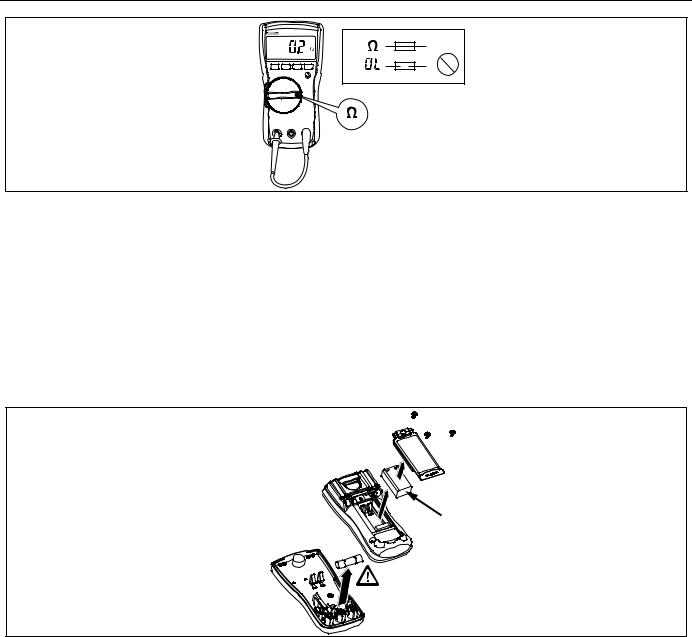Fluke 114, 116, 117, 115 User Manual

®
114, 115, 116, and 117
Digital Multimeters
Calibration Information
Introduction
XWWarning
To avoid electric shock or injury, do not perform the performance tests or calibration adjustment procedures unless qualified to do so.
The information provided in this document is for the use of qualified personnel only.
The 114, 115, 116, & 117 Calibration Information provides the information necessary to adjust and verify the performance of the Fluke Models 114, 115, 115C, 116, 116C, 117, and 117C True RMS Multimeters (hereafter known as the Meter). When specific models are noted in this manual, the “C” version is also included. For example, when the listed model is 115, the instructions are applicable to the 115C as well.
The following information is included in this document:
•Safety Information and International Electrical Symbols (page 2)
•Specifications (page 3)
•Testing the Fuse (page 5)
•Replacing the Fuse and the Battery (page 6)
•Cleaning (page 7)
•Performance Tests (page 7)
•Calibration Adjustment (page 12)
•Replacement Parts and Accessories (page 17)
•Complete Warranty (page 19)
See the 114, 115, 117 Users Manual or the 115C, 117C Users Manual or the 116 Users Manuals or the 116C Users Manual for complete operating instructions.
Service Information
To contact Fluke, call one of the following telephone numbers:
USA: 1-888-99-FLUKE (1-888-993-5853)
Canada: 1-800-36-FLUKE (1-800-363-5853)
Europe: +31 402-675-200
Japan: +81-3-3434-0181
Singapore: +65-738-5655
Anywhere in the world: +1-425-446-5500
Or, visit Fluke's Web site at www.fluke.com.
To register your product, visit register.fluke.com
September 2006 ©2006 Fluke Corporation. All rights reserved. |
1 |

114, 115, 116, and 117
Calibration Information
Safety Information
"Warning" and "Caution" Statements
A “XW Warning" identifies hazardous conditions and actions that could cause bodily harm or death.
A "W Caution" identifies conditions and actions that could damage the Meter, the equipment under test, or cause permanent loss of data.
XWWarnings and Precautions
To avoid possible electric shock or personal injury, follow these guidelines:
•Use the Meter only as specified in this manual or the protection provided by the Meter might be impaired.
•Do not use the Meter or test leads if they appear damaged, or if the Meter is not operating properly.
•Always use proper terminals, switch position, and range for measurements.
•Verify the Meter's operation by measuring a known voltage. If in doubt, have the Meter serviced.
•Do not apply more than the rated voltage, as marked on Meter, between terminals or between any terminal and earth ground.
•Use caution with voltages above 30 V ac rms, 42 V ac peak, or 60 V dc. These voltages pose a shock hazard.
•Disconnect circuit power and discharge all high-voltage capacitors before testing resistance, continuity, diodes, or capacitance.
•Do not use the Meter around explosive gas or vapor.
•When using test leads or probes, keep your fingers behind the finger guards.
•Remove test leads from Meter before opening the battery door or Meter case.
•Comply with local and national safety requirements when working in hazardous locations.
•Use proper protective equipment, as required by local or national authorities when working in hazardous areas.
•Avoid working alone.
•Use only the replacement fuse specified or the protection may be impaired.
•Check the test leads for continuity before use. Do not use if the readings are high or noisy.
•Do not use the Auto-V LoZ function to measure voltages in circuits that could be damaged by this function’s low input impedance (≈3 kΩ) (114, 116 and 117).
2

Digital Multimeters
International Electrical Symbols
International Electrical Symbols
Table 1 lists the international symbols that appear in this document and on the Meter.
Table 1. Electrical Symbols
Symbol |
Description |
Symbol |
Description |
|
|
|
|
B |
AC (Alternating Current) |
I |
Fuse |
|
|
|
|
F |
DC (Direct Current) |
T |
Double Insulated |
|
|
|
|
X |
Hazardous voltage |
W |
Important Information; Refer to manual |
|
|
|
|
N |
Battery (Low battery when shown on the |
J |
Earth ground |
|
display.) |
||
|
|
|
|
|
|
|
|
~ |
Do not dispose of this product as unsorted municipal waste. Contact Fluke or a qualified recycler for |
||
|
disposal. |
|
|
|
|
|
|
Specifications
Accuracy is specified for 1 year after calibration at operating temperatures of 18 °C to 28 °C, with relative humidity at 0 % to 90 %. Extended specifcifications are available at www.fluke.com.
General Specifications
Maximum voltage between any |
|
terminal and earth ground ................................... |
600 V |
Surge Protection................................................... |
6 kV peak per IEC 61010-1 600V CAT III, |
|
Pollution Degree 2 |
W Fuse for A input (115 & 117 only):.................. |
11 A, 1000 V FAST 17 kA Fuse (Fluke PN 803293) |
Display ................................................................... |
Digital: 6,000 counts, updates 4/sec |
|
Bar Graph: 33 segments, updates 32/sec |
Temperature .......................................................... |
Operating: -10 °C to +50 °C |
|
Storage: -40 °C to +60 °C |
Temperature Coefficient ...................................... |
0.1 x (specified accuracy)/°C (<18 °C or >28 °C) |
Operating Altitude ................................................ |
2,000 meters |
Battery ................................................................... |
9 Volt Alkaline, NEDA 1604A / IEC 6LR61 |
Battery Life ............................................................ |
Alkaline: 400 hours typical, without backlight |
Safety Compliances.............................................. |
Complies with ANSI/ISA 82.02.01 (61010-1) 2004, CAN/CSA-C22.2 No 61010-1-04, UL 6101B |
|
(2003) and IEC/EN 61010-1 2nd Edition for measurement Category III, 600 V, Pollution |
|
Degree 2, EMC EN61326-1 |
Certifications......................................................... |
UL, P, CSA, TÜV, ; (N10140), VDE |
IP Rating (dust and water protection)................. |
IP42 |
3

114, 115, 116, and 117
Calibration Information
Accuracy Specifications
Function |
|
Range |
|
Resolution |
Accuracy |
Model[1] |
||||
|
|
|
|
|
± ([% of Reading] + [Counts]) |
|
||||
DC millivolts |
600.0 mV |
|
0.1 mV |
0.5 % + 2 |
114, 115, 116, 117 |
|||||
|
6.000 |
V |
|
0.001 V |
|
|
|
|
|
|
DC Volts |
60.00 |
V |
|
0.01 V |
0.5 % + 2 |
114, 115, 116, 117 |
||||
|
600.0 |
V |
|
0.1 V |
|
|
|
|
|
|
|
|
|
|
|
DC, 45 to 500 Hz |
|
500 Hz to 1 kHz |
|
||
Auto-V LoZ[2] True-rms |
600.0 |
V |
|
0.1 V |
2.0 % + 3 |
|
|
4.0 % + 3 |
114, 116, 117 |
|
|
|
|
|
|
45 to 500 Hz |
|
|
500 Hz to 1 kHz |
|
|
AC millivolts[2] True-rms |
600.0 mV |
|
0.1 mV |
1.0 % + 3 |
|
|
2.0 % + 3 |
114, 115, 116, 117 |
||
|
6.000 |
V |
|
0.001 V |
|
|
|
|
|
|
AC Volts[2] True-rms |
60.00 |
V |
|
0.01 V |
1.0 % + 3 |
|
|
2.0 % + 3 |
114, 115, 116, 117 |
|
|
600.0 |
V |
|
0.1 V |
|
|
|
|
|
|
Continuity |
600 Ω |
|
|
1 Ω |
Beeper on <20 Ω, off >250 Ω; detects opens |
114, 115, 116, 117 |
||||
|
|
|
|
|
or shorts of 500 μs or longer. |
|
||||
|
600.0 |
Ω |
|
0.1 Ω |
0.9 % + 2 |
|
||||
|
6.000 kΩ |
|
0.001 kΩ |
0.9 % + 1 |
|
|||||
Ohms |
60.00 kΩ |
|
0.01 kΩ |
0.9 % + 1 |
114, 115, 116, 117 |
|||||
600.0 kΩ |
|
0.1 kΩ |
0.9 % + 1 |
|||||||
|
|
|
||||||||
|
6.000 MΩ |
|
0.001 MΩ |
0.9 % + 1 |
|
|||||
|
40.00 MΩ |
|
0.01 MΩ |
1.5 % + 2 |
|
|||||
Diode test |
2.000 |
V |
|
0.001 V |
0.9 % + 2 |
115, 116, 117 |
||||
Capacitance |
1000 nF |
|
1 nF |
1.9 % + 2 |
115, 116, 117 |
|||||
|
10.00 |
μF |
|
0.01 μF |
1.9 % + 2 |
|
||||
|
100.0 |
μF |
|
0.1 μF |
1.9 % + 2 |
|
||||
|
9999 μF |
|
1 μF |
100 μF - 1000 μF: 1.9 % + 2 |
|
|||||
|
|
|
|
|
>1000 μF: 5 % + 20 |
|
||||
Lo-Z Capacitance (Power- |
|
1 nF to 500 |
μF |
20% + 2 |
115, 116, 117 |
|||||
up option) |
|
(10% +2 |
typical) |
|
||||||
|
|
|
|
|
||||||
|
6.000 |
A |
0.001 A |
|
|
|
|
|
||
AC Amps True-rms[2] |
10.00 |
A[4] |
0.01 A |
|
|
|
|
|
||
20 A overload for 30 |
|
1.5 % + 3 |
115, 117 |
|||||||
(45 Hz to 500 Hz) |
|
|||||||||
seconds maximum, 10 |
|
|
|
|
|
|
||||
|
|
|
|
|
|
|
||||
|
minutes rest minimum. |
|
|
|
|
|
|
|||
|
6.000 |
A |
0.001 A |
|
|
|
|
|
||
|
10.00 |
A[4] |
0.01 A |
|
|
|
|
|
||
DC Amps |
20 A overload for 30 |
|
1.0 % + 3 |
115, 117 |
||||||
|
seconds maximum, 10 |
|
|
|
|
|
|
|||
|
minutes rest minimum. |
|
|
|
|
|
|
|||
Temperature (Type K |
-40 °C to 400 °C |
0.1 °C |
1.0 % + 10[5] |
116 |
||||||
thermocouple) |
-40 °F to 752 °F |
0.2°F |
1.0 % + 18[5] |
|||||||
|
||||||||||
AC μAmps True-rms[2] |
600.0 |
μA |
0.1 μA |
1.5 % + 3 (2.5 % + 3 > 500 Hz) |
116 |
|||||
(45 Hz to 1 kHz) |
|
|
|
|
||||||
|
|
|
|
|
|
|
|
|
||
DC μAmps |
600.0 |
μA |
0.1 μA |
1.0 % + 2 |
116 |
|||||
4

|
|
|
|
|
|
Digital Multimeters |
|
|
|
|
|
|
|
Basic Maintenance |
|
|
Accuracy Specifications (cont) |
|
|
|
|
|
|
|
|
|
|
|
|
|
|
|
Function |
Range |
|
Resolution |
Accuracy |
Model[1] |
|
|
|
|
|
|
± ([% of Reading] + [Counts]) |
|
|
|
|
99.99 Hz |
|
0.01 Hz |
|
|
|
|
Hz (V or A input)[3] |
999.9 Hz |
|
0.1 Hz |
0.1 % + 2 |
115, 116, 117 |
|
|
9.999 kHz |
|
0.001 kHz |
|
|||
|
|
|
|
|
|
||
|
|
50.00 kHz |
|
0.01 kHz |
|
|
|
Notes:
[1]Models listed in this column also refer to the “C” version of the model. For example, those rows containing model 115 are applicable to the 115C as well.
[2]All ac ranges except Auto-V LoZ are specified from 1 % to 100% of range. Auto-V LoZ is specified from 0.0 V. Because inputs below 1 % of range are not specified, it is normal for this and other true-rms meters to display non-zero readings when the test leads are disconnected from a circuit or are shorted together. For volts, crest factor of ≤3 at 4000 counts, decreasing linearly to 1.5 at full scale. For amps, crest factor of ≤3. AC volts is ac-coupled. Auto-V LoZ, AC mV, AC μamps, and AC amps are dc-coupled.
[3]AC Volts Hz is ac-coupled and specified from 5 Hz to 50 kHz. AC Amps Hz is dc-coupled and specified from 45 Hz to 5 kHz.
[4]>10 A unspecified.
[5]Temperature uncertainty (accuracy) does not include the error of the thermocouple probe.
Input Characteristics
Function |
Input Impedance (Nominal) |
Common Mode Rejection Ratio |
Normal Mode Rejection |
|||
(1 kΩ Unbalanced) |
||||||
|
|
|
||||
Volts AC |
>5 MΩ <100 pF |
>60 dB at dc, 50 or 60 Hz |
|
|||
Volts DC |
>10 MΩ <100 pF |
>100 dB at dc, 50 or 60 Hz |
>60 dB at 50 or 60 Hz |
|||
Auto-V LoZ |
~3 kΩ <500 pF |
>60 dB at dc, 50 or 60 Hz |
|
|||
|
Open Circuit Test Voltage |
Full Scale Voltage |
Short Circuit Current |
|||
|
|
|
|
|
|
|
Ohms |
<2.7 V dc |
To 6.0 MΩ |
|
40 MΩ |
<350 μA |
|
|
<0.7 V dc |
|
<0.9 V dc |
|||
|
|
|
|
|||
Diode Test |
<2.7 V dc |
|
2.000 V dc |
<1.2 mA |
||
Basic Maintenance
Testing the Fuse (115 & 117 only)
To test the fuse:
1.Set the rotary switch to Ω.
2.Plug a test lead into the v jack and touch the probe to the 10A jack, as shown in Figure 1. If the display shows a resistance value in the range of that shown in Figure 1, the fuse is good.
If the display reads 0L, replace the fuse and test again.
If the display shows any other value, have the Meter serviced. See “Service Information” earlier in this document.
5

114, 115, 116, and 117
Calibration Information
|
VoltAle rt |
|
|
|
117 TRUE RMS MULTIMETER |
|
|
|
|
<.5 |
OK |
|
|
Lo / H |
OK |
HOLD |
MIN MAX |
RANGE |
|
AUTO-V |
OFF |
Hz |
|
LoZ |
|
V |
|
|
|
V |
|
|
|
mV |
|
Volt |
|
A Hz |
|
Alert |
A |
|
|
A |
|
V |
|
COM |
|
||
|
10 A |
|
|
|
FUSED |
|
|
erc010f.emf
Figure 1. Fuse Testing
Replacing the Battery and Fuse
XWWarning
To avoid shock, injury, or damage to the Meter:
•Remove test leads from the Meter before opening the case or battery door.
•Use ONLY a fuse with the amperage, interrupt voltage, and speed ratings specified.
Battery
Fuse
erc011f.emf
Figure 2. Battery and Fuse Replacement
To remove the battery door for battery replacement, refer to Figure 2 while performing the following:
1.Remove the test leads from the Meter.
2.Remove the battery door screw.
3.Use the finger recess to lift the door slightly.
4.Lift the door straight up to separate it from the case.
5.The battery fits inside the battery door, which is then inserted into the case, bottom edge first, until it is fully seated. Do not attempt to install the battery directly into the case.
6.Install and tighten battery door screw.
To open the case for fuse replacement, refer to Figure 2 while performing the following: 1. Remove the test leads from the Meter.
6
